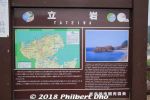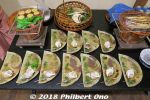 Image search results - "Tango" Image search results - "Tango" |

Tango Peninsula in northern Kyoto Prefecture is scenic along the coast with a number of natural features and formations.Much of the coast is part of the San'in Kaigan Geopark (山陰海岸ジオパーク) that extends from the western half (Kyotango city) of Tango Peninsula to Tottori Prefecture. San'in Kaigan Geopark is also a UNESCO Global Geopark.
|
|

These photos were taken while cycling along the Tango Peninsula.
|
|

Tango Peninsula coast.
|
|

Tango Matsushima (pine islands).
|
|

Tango Matsushima (pine islands).
|
|

Byobu Iwa rock.
|
|

Tateiwa Rock on the Tango Peninsula, northern Kyoto. The swimming beach leading to Tateiwa is named Tateiwa Nochigahama (立岩後ヶ浜海水浴場).
|
|

Tateiwa Rock on Tango Peninsula.Map (Tateiwa): https://goo.gl/maps/QDHmG1qArez
|
|

About Tateiwa Rock.
|
|

How Tateiwa Rock formed. This large mass of volcanic rock formed when the magma erupted and accumulated within the earthen strata below the surface. The magma didn't break the surface. However, the surrounding strata was soft and eventually eroded to expose only this hard volcanic rock called Tateiwa (Standing Rock).
|
|

Tateiwa Rock
|
|

Tateiwa Rock
|
|
|
|
|

San'in Kaigan Geopark (山陰海岸ジオパーク) area.
|
|

San'in Kaigan Geopark (山陰海岸ジオパーク)
|
|

San'in Kaigan Geopark (山陰海岸ジオパーク) from Kyoto to Tottori.
|
|
|

Visited a Tango chirimen company called Tayuh Textile Co., Ltd. (Tayuh Kigyo 田勇機業株式会社). http://www.tayuh.jp/
|
|

Tayuh Textile Co.'s chirimen textile factory in Kyotango.
|
|

Lobby of Tayuh Textile Co.
|
|

First we saw Tayuh Textile Co.'s gift shop and showroom.
|
|

Tayuh Kigyo's third-generation company president Tamoi Hayato (田茂井 勇人) first explained about their chirimen manufacturing process.These looping punch cards called "mon-gami" (紋紙) program the Jacquard loom to weave the design on the fabric. The holes in the punch cards tell the loom which threads are to be raised or not during the weaving process. These punch cards can be made by computer now.
|
|

He showed us the finished product, a chirimen fabric with a woven design.
|
|

This is 3,000 silk cocoons. That's how much silk is needed to make silk fabric for one kimono. One cocoon has 1200–1500 meters of silk thread. Since Japan produces very little silk, most are imported from China and Brazil. The Tango region consumes about one-third of Japan's raw silk imports. We were told the quality of silk from China and Brazil is very good.
|
|

Tayuh Kigyo's company motto: "A company that boasts quality has a future."
|
|

Tayuh Textile Co. makes almost everything, from the silk threads to the fabrics. We toured their impressive factory. These are spools of silk being made into threads.
|
|
|

This is a thread twister to twist the horizontal silk threads (weft) 3,000 to 4,000 times. This is a key step and how chirimen gets its crimped surface. After being woven into the fabric, the highly twisted weft threads try to untwist, creating the crimping.
|
|
|
|
|

Tayuh Kigyo's factory has 60 mechanized looms (50 of them are Jacquard looms).
|
|

Very noisy and very fast-moving. One employee monitors several looms.
|
|
|
|
|
|

Fascinating to watch.
|
|
|
|

Within Tayuh Kigyo's factory grounds, there's also the Garden of Hosenju (蓬仙寿の庭) designed by Shigemori Mirei (1896–1975 重森三玲), a famous Japanese garden designer.
|
|

Garden of Hosenju (蓬仙寿の庭), Kyotango, Kyotohttp://www.tayuh.jp/
|
|
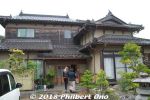
Tango chirimen silk fabric maker Tamiya Raden (民谷螺鈿).
|
|

Tamiya Raden (民谷螺鈿) had this stunning silk kimono on display for us. "Raden" means inlay (using shell, ivory, etc.). Typically, we think of lacquerware, but they do it on fabrics. This kimono took 2.5 years to make and is worth more than a Lamborghini or Rolls Royce.
|
|

Company president Tamiya Kyoji answered our many questions about this amazing kimono. His father Tamiya Katsuichiro took two years to develop and invent a method to inlay shell pieces in fabrics and showed their first example on a kimono obi sash in 1977.
|
|

The kimono was woven with pearly shell pieces from five species of oysters. Might be hard to see which parts of the kimono are the shell inlay, but the shiny parts are not the shell pieces. Very glittery.
|
|
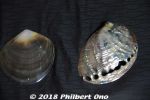
Pearly shells used in their fabrics.
|
|

First they attach the thin shell/pearly layers on a design on washi paper.
|
|

It's a painstaking, time-consuming process.
|
|

The completed design on washi paper is then sliced into "threads" that will be woven into the fabric.
|
|

Working on an obi sash.
|
|

Working on an obi sash.
|
|
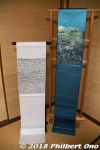
Tamiya Raden also makes kimono obi sashes.They also supply fabrics to world-famous luxury brands, but they can't brag about it because of a non-disclosure agreement.
|
|

This is a replica of an obi sash that was selected and worn by Empress Michiko recently for her birthday.The company is especially proud of this, but can't publicly brag about it. (The empress does not know who made the obi. She just liked the design.)
http://tamiya-raden.jp/
|
|

Another stop was a Tango chirimen wholesaler named Yoshimura Shouten (株式会社 吉村商店 峰山支店). Founded in 1830 and based in Kyoto city, this is their branch shop in in Mineyama, Kyotango.
|
|

They are in this distinctive, traditional building rebuilt in 1930 after the big 1927 Tango earthquake.
|
|
|
|

Inside Yoshimura Shouten. They have a small office space on the right, meeting room on the left, a fireproof kura storehouse in the back, and lots of floor space for textile merchandise.
|
|

Mineyama Branch Manager Yoshioka Hitoshi shows a PR poster of Bando Tamasaburo V posing with a Tango chirimen fabric in front of the shop's kura storehouse near where Yoshioka is standing.Tamasaburo V is one of the most famous and popular kabuki actors in Japan and Living National Treasure. He loves Tango chirimen fabrics and kabuki costumes also use Tango chirimen.
|
|

Inside their kura storehouse.
|
|

Yoshimura Shouten also creates its own designs like this "Hollywood chirimen" prototype with the the likeness of Audrey Hepburn, Charlie Chaplin, and Marilyn Monroe.
|
|

Chirimen fabric inspector uses a light box to carefully check for any defects and flaws in the material. Any defects in the material will reduce its value and the fabric (or kimono) will be sold for less.
|
|

Seal of approval on chirimen fabric.
|
|
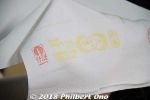
Seal of approval on chirimen fabric. Although Yoshimura Shouten is mainly a wholesaler, they also sell fabrics to individuals.http://yoshimura-shouten.jp/
|
|

He even waved goodbye to us!
|
|

Banner commemmorating the 300th anniversary of Tango chirimen in 2018.
|
|

Established in 1811, Kotohira Jinja Shrine (nicknamed Konpira-san 金刀比羅神社) in Kyotango, Kyoto mainly worships Konpira (aka Kompira), the god who protects sailors, fishermen, ocean transport, navy personnel, and other seafaring people. People also pray here for business prosperity, family safety, scholastic excellence, safe childbirth, recovery from illness, and more. There are at least 30 Kotohira/Konpira Shinto shrines in Japan and the headquarters shrine is Kotohira-gu Shrine in Kotohira, Kagawa Prefecture in Shikoku.
|
|

This shrine in Mineyama, Kyotango greatly benefited from the patronage of rich, local Tango chirimen makers and it is unique for its koma-neko cat guardians.
|
|
|
|

Japan Heritage banner marking the 300th anniversary of Tango chirimen.
|
|

Kotohira Shrine's head priest Wakisaka Takuji (宮司 脇坂卓爾) explained it to us.
|
|

Kotohira Shrine has this unique affiliate shrine named "Kishima Shrine" (木島神社) which is the left half of this building. (The right-half shrine is Sarutahiko Shrine [猿田彦神社] for the god of transportation and directions.)Kishima Shrine is unique in Japan for these two koma-neko cat guardians. Shrines usually have koma-inu lion-dog guardians (to ward off evil spirits), but only this shrine in all of Japan has cat guardians instead.
|
|
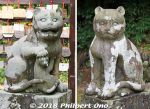
Kishima Shrine has koma-neko cat guardians because silk farmers in the 19th century kept cats to protect their precious silkworms and cocoons from rats. Rats were a major problem for the silk industry.They ate the silk cocoons and worms. So cats saved the local silk industry.
The left cat is the mother (holding a kitten), and right cat is the father. Also respectively "A" and "un."
These koma-neko cat guardian statues were donated in 1832 by silk merchants and wholesalers such as the Tonomura family (外村家一族、岩滝のちりめん問屋、山家屋の小室利七) who were textile merchants from Higashi-Omi (Gokasho), Shiga Prefecture.狛猫
|
|

Koma-neko ema prayer tablet.
|
|

"Koma-neko Unique in Japan"
|
|

Back view of Koma-neko.
|
|
|
|

The left koma-neko cat is the mother (holding a kitten).
|
|

Koma-inu lion dog also protects the shrine.
|
|

Kotohira Shrine's Ema Hall (絵馬舎) used for prayers for safe seafaring. This hall had a large painting of the shrine’s grand float festival held about 100 years ago.
|
|

Sadly, most all of the 30 ornate festival floats were lost in the 1927 earthquake. Only this painting of the floats remains. Small little town like this to have this many ornate floats was very unusual. Thanks to the chirimen merchants. Such glory days are long gone though, as chirimen sales peaked long ago.
|
|

Kotohra Shrine's Haiden prayer hall.
|
|

Inside Haiden prayer hall.
|
|
|

Sorehouse for the shrine's festival float and mikoshi portable shrine.
|
|
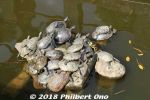
Turtle pond.http://www.konpirasan.com/
|
|

This is Shorenkan Yoshinoya (昭恋館よ志のや), a hot spring ryokan on the Tango Peninsula (Kyotango). Founded in 1928, it has 11 guest rooms.
|
|

Lobby entrance.
|
|

Lobby
|
|

Nice Japanese-style room.
|
|

View from my room.
|
|

View from my room.
|
|

This is the dressing room for the bath named "Shoren-no-Yu" (昭恋の湯). (“Shoren” means “Love of the Showa Period.” And “Yu” means hot spring water.)The ryokan had two hot spring baths, and both were designed by an American.
|
|

Dressing room.
|
|

Entrance to the bath area.
|
|

The "Shoren-no-Yu" (昭恋の湯) bath was originally an abandoned building that was renovated into a bath with a high ceiling and garden. Most everything was designed by Alexander Wilds and his artist wife Yukiko Oka. Wilds is an American sculptor from New Orleans living in Japan since 1985. He currently teaches art at Yamanashi Gakuin University in Kofu, Yamanashi Prefecture.
|
|
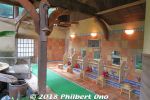
For Shoren-no-Yu, Alexander Wilds and his artist wife Yukiko Oka designed and built most everything including the garden. The shelves in the dressing room were made by his friend. Stained glass was made by his mother. Ceramic tiles are Mexican, leftover from a previous project of his. The bathhouse was originally an abandoned house which he stripped.
|
|

Since the ryokan celebrates the Showa Period (implied by the name "Shorenkan"), he aimed to make the bath have a Showa/Taisho Period feel. It was a tough job because they had to haul everything in and out manually. No accessible road so they had to roll the wooden barrel tub to the building manually (it couldn’t be rectangular). This bath was built during June to Oct. 2003.
|
|

The bath in a wooden barrel. They allowed men and women to use this bath on alternate days.http://alexanderwilds-japan.blogspot.com/2017/12/alexander-wilds-architecture-yoshinoya.html
|
|

Facing the bath's garden area.
|
|

This is the other bath named “Vidro-no-Yu” (ビードロの湯) and also designed by Alexander Wilds and his artist wife Yukiko Oka. The indoor part. The glass windows were a design highlight (hard to see because of the steam and dark night). The glass door opens to a balcony with a bath.
|
|

Outdoor baths on the balcony. It was night so I couldn't see the scenery. But it was great that we could try these two different baths during our overnight stay.
|
|
|

Indoor bathing area.
|
|

Dining room.
|
|
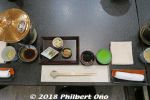
Dinner started with this.
|
|
|

Shorenkan Yoshinoya ryokan is probably more famous for its food, especially crab during crab season (Nov. to March). But it wasn't crab season when we were there so we didn't have any crab. But the food was still excellent. Kyotango, Kyoto Prefecture.
|
|
|
|

Yuzu sherbet. Yummy!
|
|
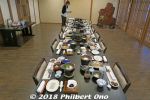
Breakfast.
|
|

BreakfastShorenkan Yoshinoya Map: https://goo.gl/maps/hAHehEVDsft
http://taiza.jp/en/
|
|

Tasted more local food here at Heshiko Kobo Hisami (へしこ工房 Hisami), a restaurant/shop in Kyotango.Map: https://goo.gl/maps/Jq7NoojH59s
http://www.hisami-kasade.com/page/shop.php#heshiko
|
|

Inside Heshiko Kobo Hisami.
|
|

A local fish delicacy called "heshiko." Heshiko is made in this coastal region of Kyoto and Fukui Prefectures. It uses mackerel (saba), sardines (iwashi), or Pacific saury (sanma) that are salted and then fermented in rice bran (nuka). For heshiko, mackerel is most popular and the process takes two years. It is a traditional way to preserve fish for later consumption without refrigeration. It was a common (and cheap) food for the masses, but now it's a delicacy.
This restaurant believes too much salt is not so healthy, so they take only two weeks to salt and ferment the fish. This method is called asazuke (浅漬け) which means "lightly pickled." We sampled the mackerel prepared this way (and grilled), but I thought it was very salty already and hardly any taste of fermentation.
|
|

Heshiko for sale.
|
|
|
|













